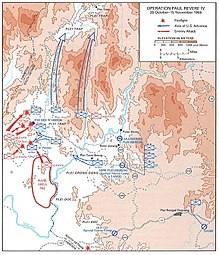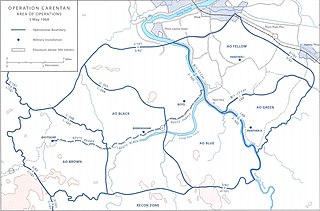
Operation Carentan and Operation Carentan II were security operations conducted during the Vietnam War by the U.S. 1st and 2nd Brigades, 101st Airborne Division and the 3rd Brigade, 82nd Airborne Division in Thừa Thiên Province, South Vietnam from 18 March to 17 May 1968.

The siege of Plei Me was the beginning phase of the first major confrontation between soldiers of the North Vietnamese People's Army of Vietnam (PAVN) and the U.S. Army during the Vietnam War. The lifting of the siege by South Vietnamese forces and American air power was followed by the pursuit of the retreating North Vietnamese from 28 October until 12 November, setting the stage for the Battle of Ia Drang.

The First Battle of Loc Ninh took place during the Vietnam War that occurred between 29 October and 7 November 1967, fought by the Viet Cong, Army of the Republic of Vietnam (ARVN), Civilian Irregular Defense Group and the United States Army.

The 22nd Division of the Army of the Republic of Vietnam (ARVN) was part of the II Corps that oversaw the region of the Central Highlands north of the capital Saigon. The 22nd Division was based in Ba Gi near the south central coast.
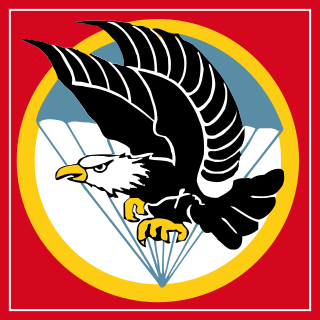
The Vietnamese Airborne Division or VNAD was one of the earliest components of the Republic of Vietnam Military Forces. The Vietnamese Airborne Division began as companies organized in 1948, prior to any agreement over armed forces in Vietnam. After the partition of Vietnam, it became a part of the Army of the Republic of Vietnam. This division had its distinct origins in French-trained paratrooper battalions, with predecessor battalions participating in major battles including Dien Bien Phu and retained distinct uniforms and regalia. With the formation of an independent republic, the colonial paratroopers were dissolved, however regalia and aesthetics alongside the nickname "Bawouans" would be retained.
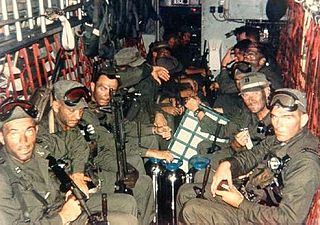
The United States continued its unilateral withdrawal of forces from South Vietnam notwithstanding the lack of progress at the Paris Peace Talks. The removal of Prince Norodom Sihanouk from power in Cambodia in March and his replacement by General Lon Nol, began the Cambodian Civil War. South Vietnamese and U.S. forces entered Cambodia in late April to attack People's Army of Vietnam (PAVN) and Vietcong (VC) bases and supply lines there which had long been used to support the insurgency in South Vietnam. The expansion of the war revitalized the antiwar movement in the U.S. and led to the Kent State shootings and Jackson State killings in May. While U.S. ground forces withdrew from Cambodia at the end of June and legislation was passed to prevent their reintroduction, the South Vietnamese conducted operations in Cambodia for the rest of the year and the U.S. provided air support and military aid to the Cambodian government. Despite this support the Cambodians lost control of vast areas of the country to the PAVN. Within South Vietnam the second half of the year saw a reduction in large U.S. operations with the focus shifting to pacification and population security and supporting Vietnamization. The PAVN/VC generally reverted to sapper attacks and attacks by fire but they fought hard to defend their base areas and infiltration routes.

Plei Djereng Camp is a former U.S. Army and Army of the Republic of Vietnam (ARVN) base northwest of Pleiku in the Central Highlands of Vietnam.

Operation Sam Houston was a US Army operation that took place in the Plei Trap Valley and around Plei Doc, lasting from 12 February to 5 April 1967.

Operation Paul Revere was a 3rd Brigade, 25th Infantry Division operation that took place west of Pleiku, lasting from 10 May to 31 July 1966. Total US casualties were 66 killed, while the US had claimed that North Vietnamese losses were 546 killed and 68 captured.

Operation Lincoln was an operation conducted by the 1st Cavalry Division west of Pleiku, lasting from 25 March to 8 April 1966, with the goal of locating suspected North Vietnamese and Viet Cong bases to disrupt any planned offensives during the monsoon season.
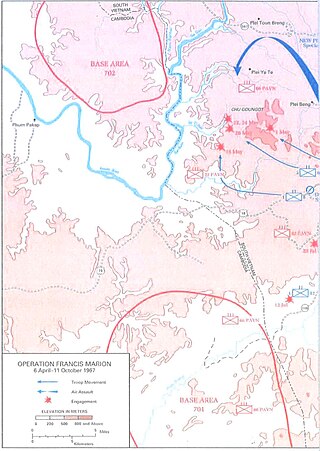
Operation Francis Marion was a 4th Infantry Division and 173rd Airborne Brigade operation that took place in Pleiku, Darlac and Kon Tum Provinces, South Vietnam, lasting from 6 April to 11 October 1967.
Operation Austin IV was a search and destroy operation conducted by the 1st Brigade, 101st Airborne Division and the 173rd Airborne Brigade in western Quang Duc and Phước Long Provinces, from 1 to 18 May 1966.
Operation Shenandoah II was a security operation conducted during the Vietnam War by the U.S. 1st Infantry Division to secure and repair Highway 13, South Vietnam from 29 September to 19 November 1967.
Phase III of the Tet offensive of 1968 was launched by the People's Army of Vietnam (PAVN) and Viet Cong (VC) from 17 August to 27 September 1968. The offensive was divided into two waves of attacks from 17 to 31 August 1968 and from 11 to 27 September of that same year.
The Battle of Trung Nghia took place from 8 June to 16 September 1973 when North Vietnamese forces captured the village of Trung Nghia in the Central Highlands of South Vietnam. The North Vietnamese were eventually forced out by the South Vietnamese.
Operation Green River was a security operation during the Vietnam War conducted by the 1st Brigade, 5th Infantry Division in Quảng Trị Province from 19 January to 22 July 1970.
Operation Randolph Glen was a joint U.S. Army and Army of the Republic of Vietnam (ARVN) military operation during the Vietnam War designed to keep pressure on the People's Army of Vietnam (PAVN) units in Thừa Thiên Province and prevent them from mounting any attacks on the populated coastal regions.
Operation MacArthur was a United States Army military operation in the Central Highlands of South Vietnam from 12 October 1967 to 31 January 1969. The early phases of the operation encompassed the Battle of Dak To from 3 to 23 November 1967.
The DMZ Campaign (1969–71) was a military campaign by the United States Army, United States Marine Corps (USMC) and the Army of the Republic of Vietnam (ARVN) against the People’s Army of Vietnam (PAVN) along the Vietnamese Demilitarized Zone (DMZ) in northern Quảng Trị Province from 1969 to 1971 during the Vietnam War.

Operation Wayne Grey was an operation carried out by the United States Army, 1st Brigade, 4th Infantry Division and supporting elements, on March 1 to April 14, 1969. Its main objective was to cut off lines of communication and supply to the People's Army of Vietnam (PAVN) 24th and 66th Infantry Regiments as well as preventing them from retreating into Cambodia.
